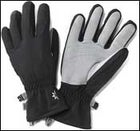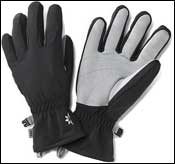That shouldn’t be hard to put together, Mychael. The keyas in so many thingsis to think in terms of layering, not just a single glove.
 One Glove
One Glove
In fact, I’d probably take three pairs of gloves. After all, Cotopaxi and ChimaborazoEcuadoran volcanoes of just over 19,000 and 20,000 feet of elevation, respectivelyare both mountains that rise out of a warm climate, so while things can get plenty cold in the last 5,000 feet, until then you’re apt to run into all sorts of temperatures. So pack a couple pairs of light liner gloves such as Manzella’s Z-Base Liner Gloves ($17; www.manzella.com). These are great all-purpose lightweight gloves, and even have an anti-microbial finish so they don’t get all smelly.
Next, get some gloves with real insulating power. An excellent glove for these climbs would be REI’s One Glove ($46; www.rei.com). Made with Polartec Power Shield and with leather palms, these gloves are astonishingly windproof, warm, and dexterous. They may be all you need once you near the summitI know I wore a very similar pair (same material, different maker) on a Rainer climb two years ago and my hands were fine despite howling winds and temps in the teens.
But, to be on the safe side, pack along some shells that can slip over the Ones, or use by themselves. Outdoor Research’s Arete gloves ($79; www.orgear.com) have a Schoeller fabric outer, a Gore-Tex liner, and a 100-weight fleece liner that’s removable. So you can use them by themselves, over a liner glove, or as a shell over the Ones.
Have fun on those climbs! Be sure to acclimate wellthose are tall mountains, and the biggest risk on them is altitude-related, such as pulmonary or cerebral edema.


